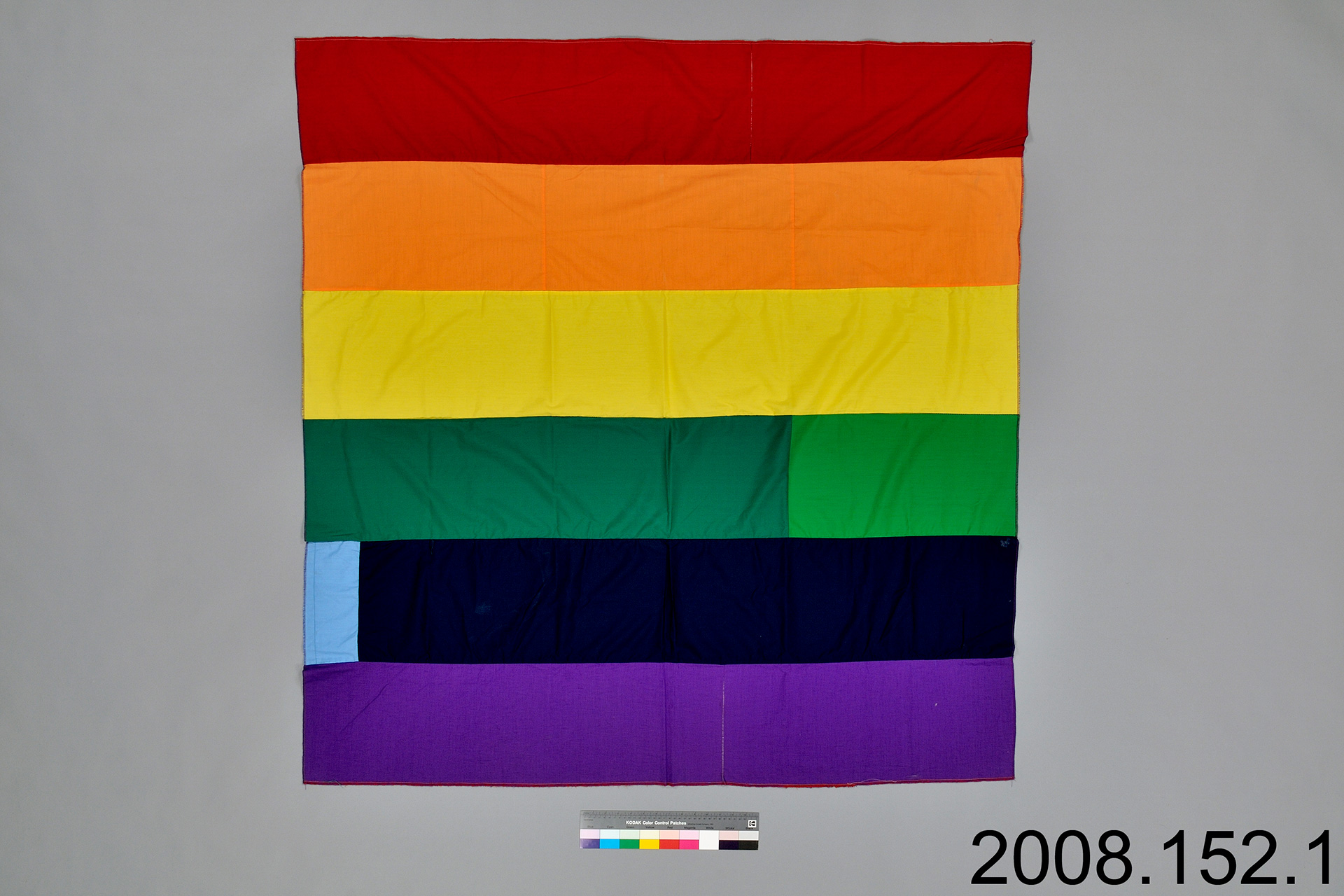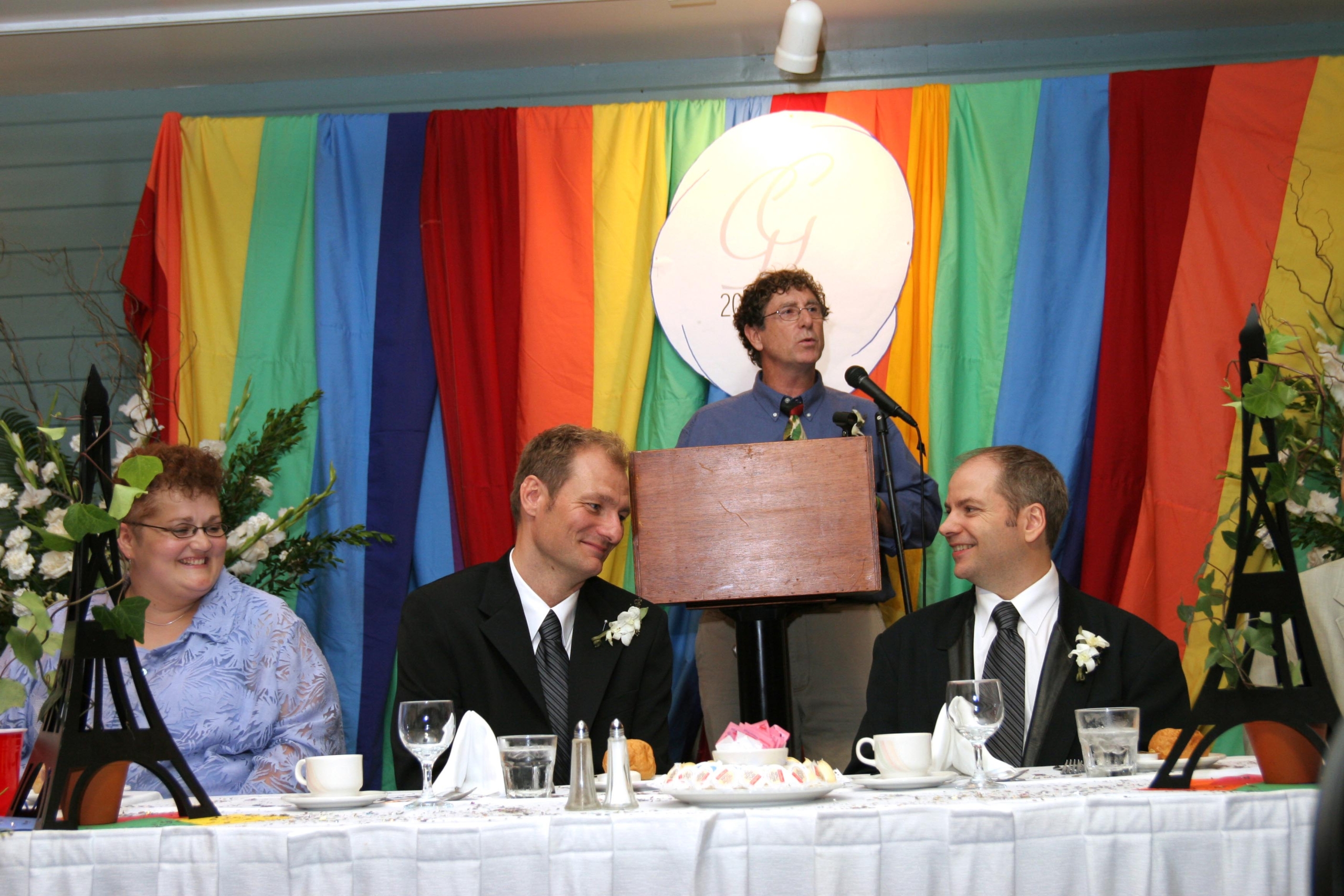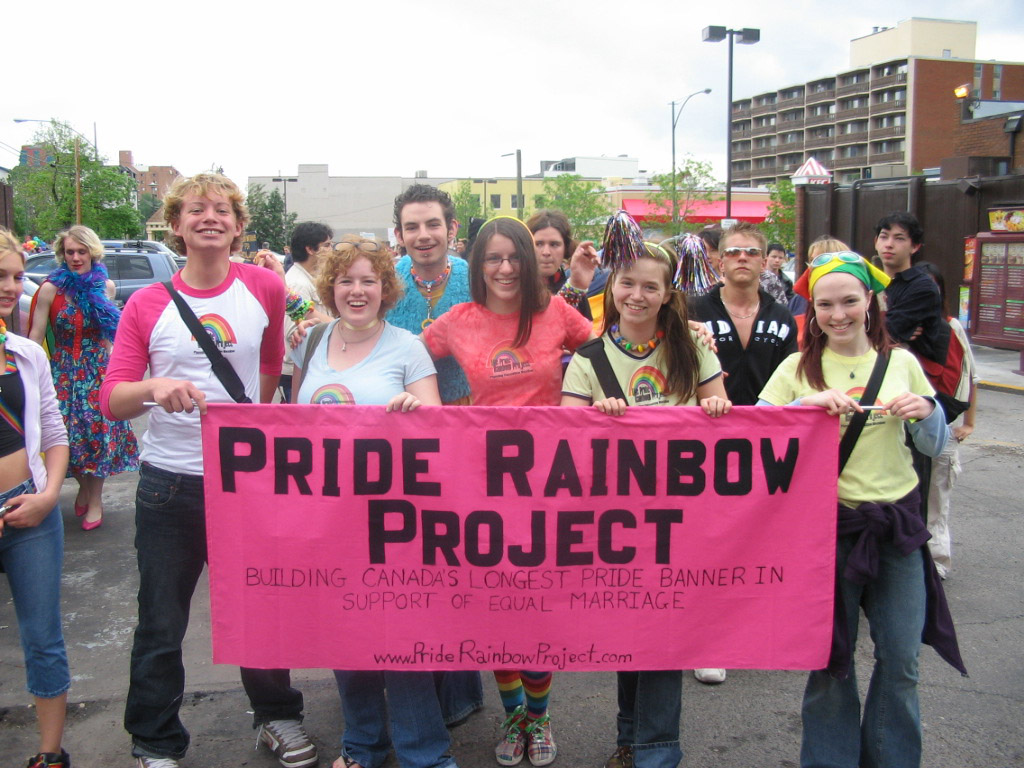Section of Pride Rainbow Project Banner
Artifact
Image
Video
Audio
 Activities
Activities
Look
Associate a feeling or emotion with each colour on the banner. What do you think the meaning of the selected colours represent? Do additional research to support your findings.
Do
Make a list of countries that have not yet legalized equal (same-sex) marriage.
Details
 Materials
Materials - Cotton
- Polyester
Historical Context
Choose one of the three levels below to match your needs.
- This is a section of a 150-metre rainbow banner made in 2005 by a Unitarian Church youth group in Calgary, Alberta, to show support for equal (same-sex) marriage.
- Following a rally in Ottawa, it was cut into sections and presented to community members. Gilles Marchildon and Gord Klassen of Ottawa used this piece of the banner at their 2005 wedding celebrations.
- Following court decisions and intense public debate, the federal government passed the Civil Marriage Act in July 2005, making Canada only the fourth country in the world to legalize equal (same-sex) marriage.
Scroll through the media carousel above to see a photograph from Gilles Marchildon and Gord Klassen’s wedding, and a photograph from the Pride Rainbow Project.
Photo: Pat Croteau — Courtesy of Christine Mishra and Dorothy Bond
This is a section of a 150-metre rainbow banner made in 2005 by a Unitarian Church youth group in Calgary, Alberta, to show support for equal (same-sex) marriage.
2SLGBTQIA+ organizations and leaders have fought for equal access and treatment within a broad range of civil institutions. Many saw the right to marry as integral to a public acknowledgement of equality.
Following a series of provincial and federal court decisions affirming the right to equal treatment for civil marriage, the federal government announced plans to reform federal civil-marriage legislation to include same-sex unions.
In early 2005, Sanford Kome-Pond, Cora Bailey, Emily Johnson, Erin James, and Christine Michell — friends in a Unitarian Church youth group in Calgary — sewed a 150-metre rainbow banner to use at a rally in support of the Civil Marriage Act, then being debated in Parliament.
The banner was later cut into sections and presented to community members. Gilles Marchildon and Gord Klassen used this piece at their 2005 wedding in Ottawa, shortly after the legislation had been passed. The new law made Canada only the fourth country in the world to recognize equal marriage for all.
This is a section of a 150-metre rainbow banner made in 2005 by a Unitarian Church youth group in Calgary, Alberta, to show support for equal (same-sex) marriage.
2SLGBTQIA+ organizations and leaders have fought for equal access and treatment within a broad range of civil institutions. The campaign for equal marriage was perhaps one of the most prominent of these fights.
Many saw the right to marry as integral to a public acknowledgement of equality. Following a series of provincial and federal court decisions affirming the right to equal treatment for civil marriage — while also recognizing the right of religious leaders to refuse to perform marriage rites that were contrary to their faith — the federal government announced plans to reform civil-marriage legislation to include same-sex unions.
Debates surrounding the Civil Marriage Act of 2005 were intense. In Calgary, a Unitarian Church youth group sought a creative way to show their support for equal marriage. Sanford Kome-Pond, Cora Bailey, Emily Johnson, Erin James, and Christine Michell created this 150-metre rainbow banner as a display of solidarity, and brought it to Ottawa for a rally on Parliament Hill.
The banner was later cut into sections and presented to community members. Gilles Marchildon and Gord Klassen used this piece at their 2005 wedding in Ottawa, shortly after the historic law had been passed. The law made Canada only the fourth country in the world to recognize equal marriage for all.
- This is a section of a 150-metre rainbow banner made in 2005 by a Unitarian Church youth group in Calgary, Alberta, to show support for equal (same-sex) marriage.
- Following a rally in Ottawa, it was cut into sections and presented to community members. Gilles Marchildon and Gord Klassen of Ottawa used this piece of the banner at their 2005 wedding celebrations.
- Following court decisions and intense public debate, the federal government passed the Civil Marriage Act in July 2005, making Canada only the fourth country in the world to legalize equal (same-sex) marriage.
Scroll through the media carousel above to see a photograph from Gilles Marchildon and Gord Klassen’s wedding, and a photograph from the Pride Rainbow Project.
Photo: Pat Croteau — Courtesy of Christine Mishra and Dorothy Bond
This is a section of a 150-metre rainbow banner made in 2005 by a Unitarian Church youth group in Calgary, Alberta, to show support for equal (same-sex) marriage.
2SLGBTQIA+ organizations and leaders have fought for equal access and treatment within a broad range of civil institutions. Many saw the right to marry as integral to a public acknowledgement of equality.
Following a series of provincial and federal court decisions affirming the right to equal treatment for civil marriage, the federal government announced plans to reform federal civil-marriage legislation to include same-sex unions.
In early 2005, Sanford Kome-Pond, Cora Bailey, Emily Johnson, Erin James, and Christine Michell — friends in a Unitarian Church youth group in Calgary — sewed a 150-metre rainbow banner to use at a rally in support of the Civil Marriage Act, then being debated in Parliament.
The banner was later cut into sections and presented to community members. Gilles Marchildon and Gord Klassen used this piece at their 2005 wedding in Ottawa, shortly after the legislation had been passed. The new law made Canada only the fourth country in the world to recognize equal marriage for all.
This is a section of a 150-metre rainbow banner made in 2005 by a Unitarian Church youth group in Calgary, Alberta, to show support for equal (same-sex) marriage.
2SLGBTQIA+ organizations and leaders have fought for equal access and treatment within a broad range of civil institutions. The campaign for equal marriage was perhaps one of the most prominent of these fights.
Many saw the right to marry as integral to a public acknowledgement of equality. Following a series of provincial and federal court decisions affirming the right to equal treatment for civil marriage — while also recognizing the right of religious leaders to refuse to perform marriage rites that were contrary to their faith — the federal government announced plans to reform civil-marriage legislation to include same-sex unions.
Debates surrounding the Civil Marriage Act of 2005 were intense. In Calgary, a Unitarian Church youth group sought a creative way to show their support for equal marriage. Sanford Kome-Pond, Cora Bailey, Emily Johnson, Erin James, and Christine Michell created this 150-metre rainbow banner as a display of solidarity, and brought it to Ottawa for a rally on Parliament Hill.
The banner was later cut into sections and presented to community members. Gilles Marchildon and Gord Klassen used this piece at their 2005 wedding in Ottawa, shortly after the historic law had been passed. The law made Canada only the fourth country in the world to recognize equal marriage for all.
Summary
- This is a section of a 150-metre rainbow banner made in 2005 by a Unitarian Church youth group in Calgary, Alberta, to show support for equal (same-sex) marriage.
- Following a rally in Ottawa, it was cut into sections and presented to community members. Gilles Marchildon and Gord Klassen of Ottawa used this piece of the banner at their 2005 wedding celebrations.
- Following court decisions and intense public debate, the federal government passed the Civil Marriage Act in July 2005, making Canada only the fourth country in the world to legalize equal (same-sex) marriage.
Scroll through the media carousel above to see a photograph from Gilles Marchildon and Gord Klassen’s wedding, and a photograph from the Pride Rainbow Project.
Photo: Pat Croteau — Courtesy of Christine Mishra and Dorothy Bond
Essential
This is a section of a 150-metre rainbow banner made in 2005 by a Unitarian Church youth group in Calgary, Alberta, to show support for equal (same-sex) marriage.
2SLGBTQIA+ organizations and leaders have fought for equal access and treatment within a broad range of civil institutions. Many saw the right to marry as integral to a public acknowledgement of equality.
Following a series of provincial and federal court decisions affirming the right to equal treatment for civil marriage, the federal government announced plans to reform federal civil-marriage legislation to include same-sex unions.
In early 2005, Sanford Kome-Pond, Cora Bailey, Emily Johnson, Erin James, and Christine Michell — friends in a Unitarian Church youth group in Calgary — sewed a 150-metre rainbow banner to use at a rally in support of the Civil Marriage Act, then being debated in Parliament.
The banner was later cut into sections and presented to community members. Gilles Marchildon and Gord Klassen used this piece at their 2005 wedding in Ottawa, shortly after the legislation had been passed. The new law made Canada only the fourth country in the world to recognize equal marriage for all.
In-Depth
This is a section of a 150-metre rainbow banner made in 2005 by a Unitarian Church youth group in Calgary, Alberta, to show support for equal (same-sex) marriage.
2SLGBTQIA+ organizations and leaders have fought for equal access and treatment within a broad range of civil institutions. The campaign for equal marriage was perhaps one of the most prominent of these fights.
Many saw the right to marry as integral to a public acknowledgement of equality. Following a series of provincial and federal court decisions affirming the right to equal treatment for civil marriage — while also recognizing the right of religious leaders to refuse to perform marriage rites that were contrary to their faith — the federal government announced plans to reform civil-marriage legislation to include same-sex unions.
Debates surrounding the Civil Marriage Act of 2005 were intense. In Calgary, a Unitarian Church youth group sought a creative way to show their support for equal marriage. Sanford Kome-Pond, Cora Bailey, Emily Johnson, Erin James, and Christine Michell created this 150-metre rainbow banner as a display of solidarity, and brought it to Ottawa for a rally on Parliament Hill.
The banner was later cut into sections and presented to community members. Gilles Marchildon and Gord Klassen used this piece at their 2005 wedding in Ottawa, shortly after the historic law had been passed. The law made Canada only the fourth country in the world to recognize equal marriage for all.



